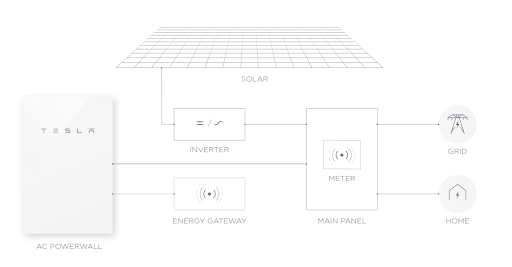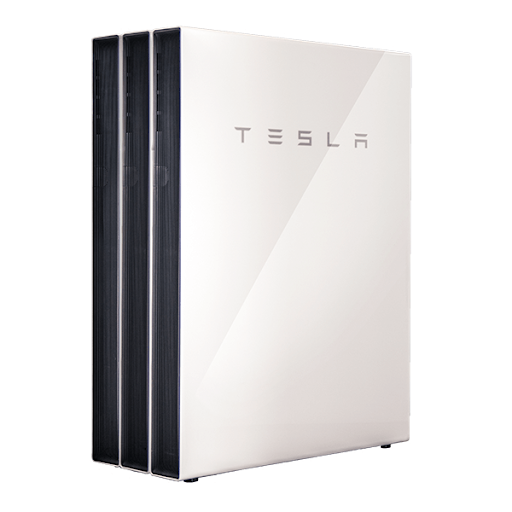What is AC and DC Coupling?
There are two main architectures for battery systems: AC and DC coupling.
DC coupling refers to both the battery and solar connecting to a single inverter. Solar and the battery need to pass through the inverter in order to power electrical loads. Therefore the power you have available is limited by the inverter rating.
For example, if you have a 5kW Hybrid inverter and you are producing 3kW of solar, you can only pull 2kW out of your batteries. If you need to service a load of 8kW, you have no choice but to provide the extra 3kW from the grid. Despite technically having 8kW of power available!
 AC Coupling is better for a home battery, in our opinion. An AC-coupled battery like the Powerwall has its own inbuilt inverter. It is able to be combined with nearly any existing solar system. In fact, you can add a Tesla Powerwall to ANY grid-tied solar system.
AC Coupling is better for a home battery, in our opinion. An AC-coupled battery like the Powerwall has its own inbuilt inverter. It is able to be combined with nearly any existing solar system. In fact, you can add a Tesla Powerwall to ANY grid-tied solar system.
AC coupling gives you more power
One of the main benefits of a battery having its own inverter is the power you can draw from your system. You can draw whatever your solar system is producing, plus your battery inverter rating.
If we use the same example above. You have an 8kW load and are producing 3kW of solar. Your Tesla Powerwall 2 battery can discharge at 5kW. 3+5=8kW. You’ll have no problem servicing your 8kW load, no need to use grid power in this case!
Take the popular solar system size of 5kW, when the sun is out you’ll potentially have access to 5kW of solar and 5kW of battery. Giving you a total of 10kW of power available. This gets even better with the Powerwall 3 which can output 10kW.
Round trip efficiency
One of the drawbacks of AC-coupled batteries is round-trip efficiency. With an AC battery, the energy is converted from DC to AC by the inverter, then back to DC to be stored in the battery, and then converted back into AC when required for use. During this process some energy loss is inevitable. However, these losses are so minimal that it makes little difference to your battery’s performance. In our opinion, this slight loss of efficiency is far outweighed by the advantages of AC-coupled batteries like the Powerwall.
Easily increase your power
 A great feature of the Powerwall 2 is its scalability. A residential Powerwall 2 system can have up to 10x batteries installed.
A great feature of the Powerwall 2 is its scalability. A residential Powerwall 2 system can have up to 10x batteries installed.
Now because each battery has its own 5kW inverter built-in, every time you add a battery you add another 5kW of discharge capacity!
For example, if you have 3x Powerwall 2’s installed, you would be able to draw 15kW of power at once just from your batteries. With a standard grid connection being 14.5kW, this is more power than you can get from the grid.
Multiple Powerwalls are very handy when designing a system for large backup loads. If you need to keep a Kiln or powerful pumps up and running, then it’s very easy to scale the number of batteries to service the load. This is not so easy with a Hybrid inverter.
Also when combining multiple Powerwall 2s, you’ll also increase your energy storage, to reduce your grid usage and keep you going longer in an outage.
Ready to add a Powerwall 2 to your Solar System? Get in touch to secure yours today.